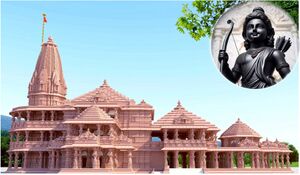Gaṇa
By Swami Harshananda
Gaṇa literally means ‘group’.
The word gaṇa has been used in several senses. The most general meaning is ‘an assemblage or a group.’ In the puraṇas the word is widely used to indicate the pramatha gaṇa.[1] Gaṇapati or Gaṇeśa, the famous and popular deity of the religion, is their leader.
Gaṇa in Purāṇas[edit]
Sometimes, the purāṇas also mention ‘gaṇadevatās,’ which are the special classes of deities. They are 422 in number distributed among nine classes as follows:
- Ādityas (12)
- Viśvedevas (10)
- Vasus (8)
- Tuṣitas (36)
- Abhāsvaras (64)
- Anilas (49)
- Mahārājikas (220)
- Sādhyas (12)
- Rudras (11)
Gaṇa in Military Science[edit]
In the military science it indicates one of the four formations of an armed force. It consists of the proportion of the four aṅgas or limbs being as follows:
- 27 elephants
- 27 chariots
- 81 horses
- 135 foot-soldiers
Gaṇa in Nakṣatras[edit]
The nakṣatras or groups of lunar mansions are also divided into gaṇas such as:
This grouping helps the astrologers to match the horoscopes of the boy and the girl for marriage.
Gaṇa in Poetry[edit]
Sanskrit prosody has eight gaṇas each comprising of three syllables. By the permutation and combination of these, several meters are obtained. For instance, the ‘ya-gana’ has three syllables, one laghu(short) and two gurus (long). Similarly the other gaṇas like ma-gaṇa, ta-gaṇa, ra-gaṇa and so on are also defined.
Gaṇa in Sanskrit Grammar[edit]
In grammar it is used to indicate the groups of certain padas or words like gaura, utsa, dhātus or verbal roots like bhu-ādi, ad-ādi and so on. They have various utility in the various grammatical processes.
Gaṇa in Law[edit]
‘Gaṇa’ is also a term signifying a certain type of courts administering the laws of republics.
References[edit]
- The Concise Encyclopedia of Hinduism, Swami Harshananda, Ram Krishna Math, Bangalore

